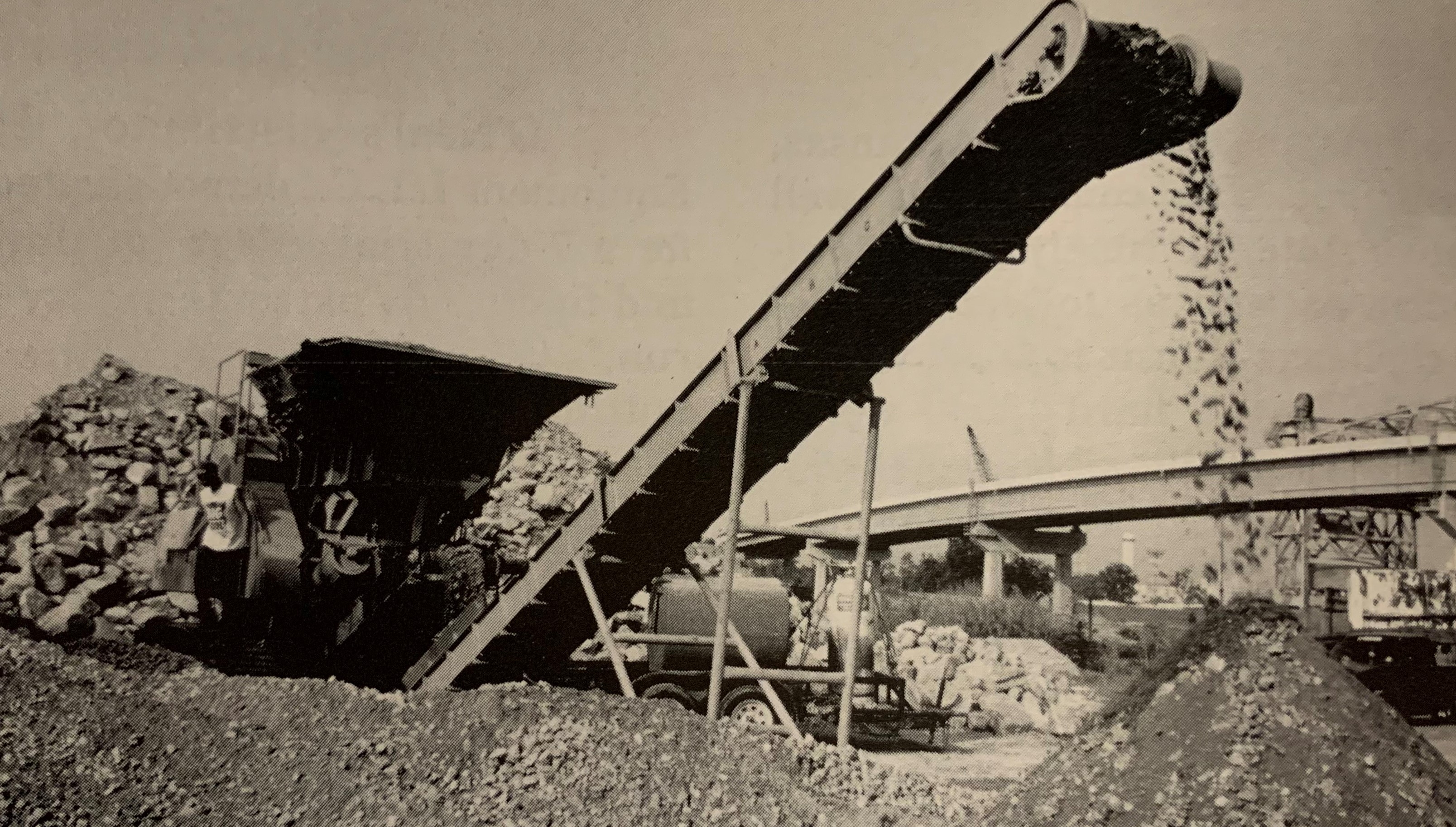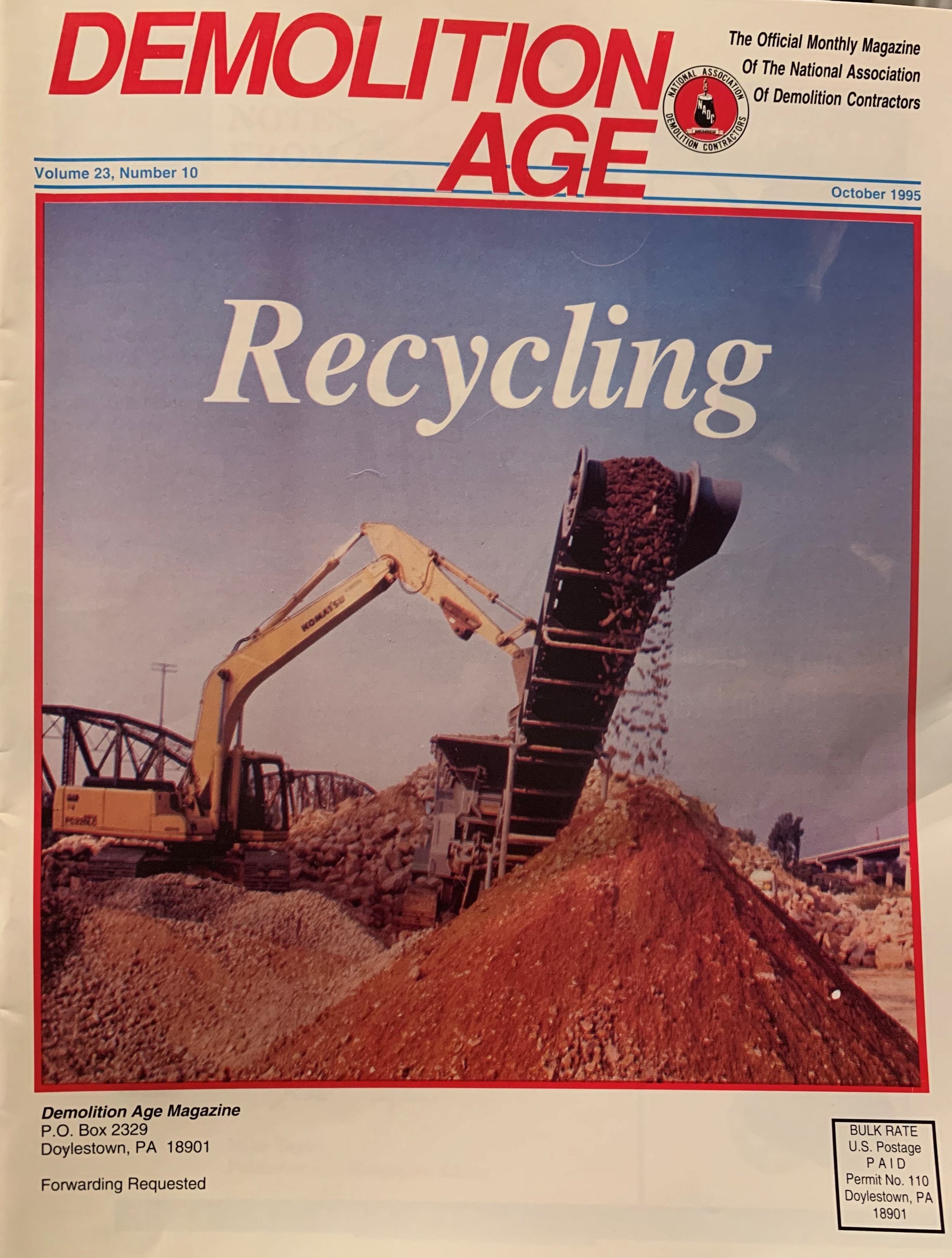Recycling in Louisiana
March 28, 2022

This article was originally published in the October 1995 issue of DEMOLITION magazine, then called Demolition Age.
In an era of increasingly stiff competition, demolition contractors often must struggle to find ways to differentiate their services in order to win new and profitable business. Fortunately, heightened environmental awareness, an intense focus on cost-cutting measures and diminishing natural stone resources in some areas of the country are collectively paving the way for recycling to become a probable — and profitable — way for a contractor to pull away from the rest of the pack.
NDA member Richard O’Neal, equipment manager for Concrete & Steel Processors Inc. of Alexandria, La., is one forward-thinking contractor who recognizes this. He has even taken the recycling approach to success one step further than his competitors by concentrating his efforts on job-site recycling and material re-sale.
The impetus for O’Neal’s approach was his lease earlier this year of a Komatsu BR300J mobile crusher. Incorporating the crusher into a variety of applications has enabled him to speed jobs, significantly reduce costs, and produce a usable, highly scalable product — all of which have helped his once-struggling business to thrive.
“Recycling of any kind is the future, but I believe that fortunes will be made in concrete recycling,” he says. “In Louisiana, virtually all existing aggregate has gone into concrete, so our approach is to get it back out of the concrete, and the BR300J enables us to do that as no other machine that we looked at could.”

Concrete & Steel Processors specializes in concrete demolition, and provides metal, glass and concrete recycling services. The firm’s 27 employees handle jobs all over the country, focusing their efforts in Louisiana, Arkansas, Texas and Mississippi. The company is well known in its native state for timely and affordable job completion, as well as for its “can-do” approach to any challenge that it is faced with.
“Our attitude is, the hard [jobs] we do immediately, and for the impossible, we take a little longer,” says O’Neal. “The bigger the challenge, the better.”
It was this attitude that O’Neal brought with him to Komatsu Dresser’s “Field Days” in Chattanooga, Tenn., early this year, when he was seeking new equipment technologies and new ways of approaching business opportunities to save his then-struggling business, and where he first saw the BR300J in action. He was impressed by the machine’s simplified operation and low noise and vibration levels, and saw it as an opportunity to win new business and reap additional revenue by offering his customers unmatched price and productivity.
“There are a lot of players out there, all doing the same things I was doing,” he said. “I realized that the BR300J could help set me apart by giving me the ability to crush material on-site and leave it there for re-use, which could save my customers considerably, both in fill material cost and landfill disposal and hauling charges. The added plus was that my business would profit more, too, in that we would not get paid just to tear up the concrete, but to crush it, as well.
The 153HP, self-propelled and hydraulically driven crusher was introduced to the U.S. market in 1994. Its 36- x 18-inch jaws use a “chewing” motion to crush up to 144 tons of stone, concrete or asphalt debris per hour, reducing it to 0.75-4.7-inch material. The completely mobile unit is built on a Komatsu PC220 hydraulic excavator undercarriage and powertrain components.
O’Neal’s distributor, Head & Endquist Equipment LLC, demonstrated for him a crusher for a 7-day trial. After “pushing it to the limit,” and finding it “extremely easy and economical to run,” O’Neal purchased the unit and began putting it to work for his business.
In August, Concrete Steel & Processors was hired to tear up and recycle 2.7 miles of state highway in Alexandria as part of a state-funded reconstruction project. A trio of Komatsu excavators equipped with a LaBounty UP40 Universal Processor, a bucket and a hydraulic hammer were used to break the highway into 39,000 sq. yd. pieces. The BR300J was brought on site to bring each of the squares to 1.5-inch minus material, 100 percent of which was stockpiled here for use as roadbed fill material in the subsequent reconstruction project. Metal debris was separated from the concrete by an optional conveyor belt and magnet attachment, and sold for scrap.
The demolition was originally scheduled to take up to 30 days, but O’Neal’s team completed it in just over two weeks. O’Neal credits the unit’s reduced transportation costs and quick set-up, as well as its elimination of hauling material to either a landfill or to and from a stationary crusher as contributing to the timely — and cost-effective — completion of this project.
“A main advantage of this machine is that it’s very mobile,” he says. “We transported it to the site on a single lowboy truck from our own fleet, and had it up and crushing in less than 10 minutes. A lot of the portable crushers I’ve seen can take as many as three trucks to get it to the job site, and then take nearly a day to set it up.”

“This job was a perfect example of the benefits that on-site recycling can provide for everyone involved,” O’Neal says. “For us, it starts with the bidding process, when we can offer faster completion times and more competitive pricing because of the capabilities the BR300J provides, and continues through an increased profit margin of anywhere from 10 to 20 percent from the elimination of trucking and disposal from overhead and the creation of a valuable end product to sell.
“The state contractor gets fill material that is exactly the size and quality he wants, at a price [$9.50 per ton] that couldn’t be beat by any outside source,” he continues. “Nearly residents remain undisturbed by a machine so quiet that you can crush rock with a baby sleeping beside it, and the environment benefits from reduced contributions to landfills.”
O’Neal also points out that he was able to pass on to his customer tremendous savings in landfill-related costs.
“Without on-site recycling, we would have had to charge approximately $22 per ton just to dispose of the debris, which is a significant amount when you realize that this job generated over 12,000Q tons of debris,” he says.
O’Neal estimates that on-site recycling has improved his job capabilities by 40 percent by enabling him to gain more business in aggregate-poor Louisiana, as well as expand his services to other areas of the country.
“This capability has increased our versatility, and opened the door to bidding a wider variety of jobs than we would have been able to do in the past,” he says.
O’Neal currently is considering the lease/purchase of a second BR300J to take on vast amounts of stockpiled concrete in his region that until now, “nobody knew what to do with.” At press time, O’Neal had booked up approximately 80,000 tons of concrete, which he planned to crush, have screened to produce aggregate of various sizes, and sell for about $11.50 per ton.
“We now have a service that nobody else in our area can offer,” he says. “I consider my LaBounty and Komatsu equipment my lifeline, and when I combine them with a team staff that works as long and as hard as it takes to get a job done, there’s really nothing we can’t do.”
